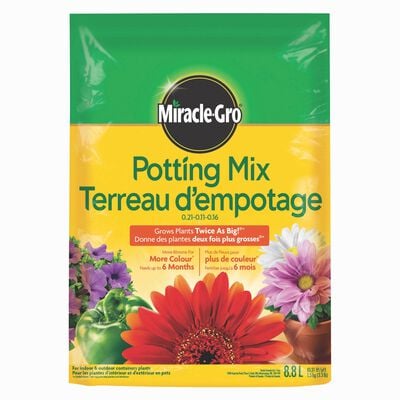
Planting, Growing & Harvesting Potatoes
Potatoes are easy to grow at home. Imagine being able to harvest "new" potatoes in the spring and early summer to eat with homegrown green beans!
Mature potatoes can be stored so that you and your family can enjoy them for many months. Even if you don't plant to fill your hall closet with potatoes, it's still fun to grow a few plants, if only to experience the novelty of digging up your dinner.
Here's how to grow potatoes.
Where to Buy Potatoes for Home Growing
It is essential to start with certified disease-free seed potatoes. These are available at home improvement, farm, and garden centers, and can also be ordered online. It's not usually a good idea to plant potatoes from the grocery store, as they've usually been treated so that they won't sprout on the shelves (and you want them to sprout).
When to Plant Potatoes
Potatoes grow best during cooler weather. Plant potatoes 2-4 weeks before the last frost in the spring, when the soil temperature is at least 40 degrees F. In warm climates, potatoes are planted from January to March and harvested between March and June. In cooler areas, potato-planting time is usually between April and June, with harvest between July and September. Consult your local cooperative extension agency to learn the best planting time for your area.
Where to Plant Potatoes
Plant potatoes where they will receive full sun, and choose and well-drained, acidic soil. Avoid planting in the same spot in which peppers, eggplants, or tomatoes were grown in the previous season, as potatoes are particularly susceptible to diseases carried by those plants.
Plant Potatoes from Seed Pieces
Potatoes need fertile, well-drained soil. Prepare in-ground garden soil by mixing 3 inches of Miracle-Gro® All Purpose Garden Soil into the top 6 to 8 inches of native soil. This will help protect from overwatering and underwatering, and give potatoes a head start on nutrition. If you plan to grow your potatoes in raised beds, fill them with Miracle-Gro® Raised Bed Soil, which is 100 percent organic and provides the right foundation for growing plants in this way. For container growing, get great results by filling pots with Miracle-Gro® Potting Mix.
Potatoes grow best in acidic soils with a pH of 4.8 to 5.5. Test soil with a soil kit and adjust the pH if necessary. (The local extension agency can tell you how).
How to Plant Potatoes
Cut seed potatoes into 1- to 2-inch squares with two to three eyes (bud sprouts) per piece, then allow them to dry for a couple of days before planting. Plant seed potatoes 12 to 18 inches apart and four inches deep. The eyes should be facing up and the cut side facing down. If planting in-ground, space rows 24 to 36 inches apart to leave room for hilling (see below) and walking between the plants.
How to Water Potatoes
Potatoes need consistent moisture, though you never want the soil to be soggy. Water plants once or twice per week, providing one to two inches of water in total. The most critical period for watering is when plants are in bloom. Be sure to water around the base of the plants, not on the leaves.
How to Hill Potatoes
Hilling potatoes keeps sunlight from reaching developing tubers and turning them green. (Green parts of potatoes contain a natural toxin called solanine and should not be eaten.) Hill potatoes by piling additional soil or potting mix halfway up around the stems when plants are about 6-8 inches tall. Continue to hill every three weeks or so, until the plants start to bloom.
How to Feed Potatoes
Begin feeding with Miracle-Gro® Shake 'N Feed® Tomato, Fruits & Vegetables Plant Food 10-5-15 a month after planting to give plants the nutrients they need to grow strong and produce lots of potatoes for you to harvest. Make sure to follow all label directions.
How to Troubleshoot when Growing Potatoes
Potatoes are susceptible to a variety of pests and diseases. Use floating row covers to protect plants from flea beetles and Colorado potato beetles early in the season, then remove covers just before plants start to bloom. Fungal and bacterial problems are best prevented by giving the plants good care: avoid watering the leaves, provide good airflow, and ensure that the pH level of the soil isn't too high.
How to Harvest and Store Potatoes
Harvest "new" (immature) potatoes for eating after the plant begins flowering. Gently scratch some soil under the plants aside and feel around for a few small tubers and pull them out, then replace the soil so the plants will keep growing. For full-sized potatoes, wait until after the tops of the plants have died. Carefully dig up the entire plant using a garden fork, doing your best not to bruise or pierce the potatoes. Bring them inside and keep them in a dark, cool, humid spot (such as an unfinished basement or garage) for two weeks to "cure" so the skins will thicken and dry for storing. Store in a covered, ventilated box or bin.
How to Grow Potatoes: Recap
- Start with certified disease-free seed potatoes.
- Plant in full sun in acidic, well-drained soil. Use Miracle-Gro® All Purpose Garden Soil for in-ground gardens, Miracle-Gro® Raised Bed Soil in raised beds, or Miracle-Gro® Potting Mix in containers.
- Water thoroughly.
- Hill potato plants as they grow.
- Feed with Miracle-Gro® Shake 'N Feed® Tomato, Fruits & Vegetables Plant Food 10-5-15 beginning a month after planting.
- Use row covers and good cultural practices to help prevent pest and disease problems.
- Harvest potatoes when growth dies back and store in a cool, humid place.
Ready to start growing potatoes? Click on any of the product links above for more information, to purchase the product online, or to find a retailer near you.



